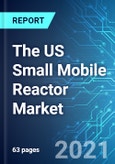This report includes opportunity analysis of SMR technology in various wings of armed forces such as Army, Navy and Air Force. Potential production volume of TRISO fuel for the years 2020-2026 has also been included in the report followed by comparison of TRISO fuel on other parameters such as fuel production reactor units, low and high cost revenue to name a few.
Under competitive landscape, players based in the US SMR market have been split on the basis of different levels in the US supply chain such as reactor designers, Uranium miners, system hardware/ software makers, TRISO producers etc.
The US SMR market is a highly fragmented one with various players operating at different levels of the SMR supply chain. Curtiss-Wright Corporation, BWX Technologies Inc., NuScale Power and HolosGen LLC are the players whose company profiling has been done in the report. In this section of the report business overview, financial overview and business strategies of the companies have been provided.
Table of Contents
1. Executive Summary
2. Introduction
2.1 Small Mobile Reactors (SMR): An Overview
2.2 Mobile Reactors Value Chain
2.3 Evolution for SMR
2.4 Types of SMR
2.5 Key Features of Different SMR Technologies
2.6 Examples of SMR Technology
2.7 Generation IV Advanced Reactors: An Overview
3. The US SMR Market Opportunity Analysis
3.1 Small Mobile Reactors (SMR): Opportunity Analysis
3.1.1 Department of Defense Sites Infrastructure Power
3.1.2 Navy
3.1.3 US Airport and Radar Infrastructure
3.1.4 Directed Energy Army Vehicles
3.2 The US Very High Temperature (VHTR) SMR Market Analysis
3.2.1 The US TRISO Market by Production Volume
4. Growth Factors
4.1 Growth Drivers
4.1.1 Rising Demand for Replacing Fossil Fuel
4.1.2 Surging Urban Population
4.1.3 Approval of Small Nuclear Reactor
5. Mobile Nuclear Power Challenges
5.1 Mobile Nuclear Reactor Requirements
5.2 Small Reactor Challenges and Additional Requirements
5.3 Technical Challenges
6. COVID-19
6.1 Impact of Covid-19
6.2 Regional Impact of COVID-19
7. Competitive Landscape
7.1 The US Small Mobile Reactor (SMR) Market Players: A Financial Comparison
7.2 Players in the US Mobile Nuclear Reactor Supply Chain
8. Company Profiles
8.1 Curtiss-Wright Corporation
8.1.1. Business Overview
8.1.2 Financial Overview
8.1.3 Business Strategy
8.2 BWX Technologies Inc.
8.2.1. Business Overview
8.2.2 Financial Overview
8.2.3 Business Strategy
8.3 NuScale Power
8.3.1 Business Overview
8.3.2 Business Strategy
8.4 HolosGen LLC
8.4.1 Business Overview
8.4.2 Business Strategy
List of Figures
Figure 1: Mobile Reactors Value Chain
Figure 2: Types of SMR
Figure 3: Examples of SMR Technology
Figure 4: Advanced Reactor Categories
Figure 5: The US DoD Site Count by Service
Figure 6: Navy Total Addressable Market
Figure 7: G/ATOR, Q53, Patriot Radar Systems
Figure 8: The US Airport and Weather Radar
Figure 9: The US TRISO Market by Production Volume; 2020-2026 (Kg)
Figure 10: The US Fossil Fuel Consumption; 2016-2020 (Quadrillion British Thermal Units)
Figure 11: The US Urban Population; 2016-2020 (Million)
Figure 12: Players in the US Mobile Nuclear Reactor Supply Chain
Figure 13: Curtiss Wright Net Sales; 2016-2020 (US$ Billion)
Figure 14: Curtiss Wright Net Sales by Segments;2020 (Percentage,%)
Figure 15: Curtiss Wright Net Sales by Region; 2020 (Percentage,%)
Figure 16: BWX Technologies Revenue; 2016-2020 (US$ Billion)
Figure 17: BWX Technologies Revenue by Segments;2020 (Percentage,%)
Figure 18: BWX Technologies Revenue by Region; 2020 (Percentage,%)
List of Tables
Table 1: Key Features of Different SMR Technologies
Table 2: Market Breakdown of US SMR Units
Table 3: Remote Locations for Mobile Reactors
Table 4: TRISO Parameters
Table 5: Mobile Nuclear Reactor Requirements
Table 6: Small Reactor Challenges
Table 7: The US Small Mobile Reactor (SMR) Market Players: A Financial Comparison; 2020
Table 8: Current Projects of NuScale Energy
Table 9: Applications of Holos Products
Executive Summary
Small Modular Reactors/Small Mobile Reactors (SMR) are defined as nuclear reactors with the electrical output capability of 300MWe (Mega Watt Electric) equivalent or less. Their size, uncomplicatedness of its very design and natural cooling are some of its important features. Many SMRs have been deployed across the globe in nuclear submarines, warships, merchant ships, icebreakers and as research and medical isotope reactors at universities.
SMR can be classified into three categories on the basis of the technology employed into Light Water Reactors (LWR), Fast Neutron Reactors (FNR) and High Temperature Gas Reactors (HTGR).
The market growth was not severely impacted owing to spread of the pandemic disease COVID-19. In addition the US SMR market holds lucrative opportunities in the years ahead. The US Department of Defense (DoD) and the FAA/US Department of Homeland Security airport/radar locations are expected to be amongst the early adopters of SMR technology. The DoD sites belonging to army, navy and air force hold potential for adoption of the SMR technology. Furthermore the factors that supported the growth of the market are rising demand for replacing fossil fuel, surging urban population and approval of small nuclear reactor.
The adoption of SMR technology is also confronted with various technical challenges. Mobile nuclear reactor requirements ranging from installation, transposability to operations and specific requirements of small reactors such as operational & maintenance cost and large EPZ to name a few are some of the crucial challenges in the way of mobile nuclear technology. Several technical challenges have been identified like need of technology development like advanced moderators, heat management, fuel and material qualification and licensing/ regulatory.
Companies Mentioned
- BWX Technologues Inc.
- Curtiss-Wright Corporation
- HolosGen LLC
- NuScale Power








